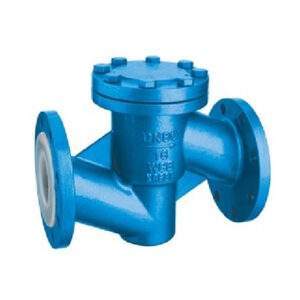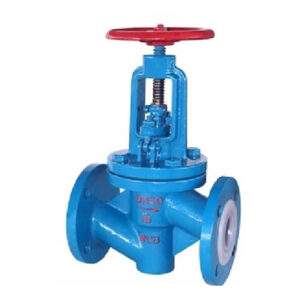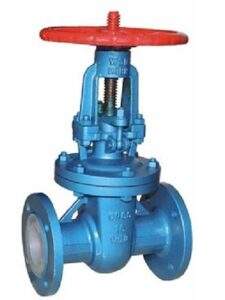Introduction

Fluorine-lined valves are essential components in various industries handling highly corrosive or aggressive media. These valves combine the mechanical strength of metal (typically cast iron, ductile iron, or steel) with the exceptional chemical resistance of fluoropolymers like PTFE (Polytetrafluoroethylene), PFA (Perfluoroalkoxy alkane), FEP (Fluorinated Ethylene Propylene), and PVDF (Polyvinylidene Fluoride). This unique combination results in valves that can withstand harsh operating conditions while ensuring reliable and leak-free performance. This blog post will delve into the numerous benefits of fluorine-lined valves, exploring their applications, advantages, and key considerations for selection and maintenance.
Understanding Fluoropolymer Linings in Valves
The core advantage of fluorine-lined valves lies in the properties of the fluoropolymer lining. These materials exhibit exceptional resistance to a wide range of chemicals, including strong acids, bases, solvents, and oxidizing agents. This makes them ideal for applications in chemical processing, pharmaceuticals, pulp and paper, and other industries where corrosion is a major concern.
Here’s a breakdown of some commonly used fluoropolymers:
- PTFE: Known for its outstanding chemical inertness, wide temperature range (-200°C to +260°C), and low coefficient of friction.
- PFA: Similar to PTFE in chemical resistance but offers improved mechanical properties and higher temperature resistance (up to +260°C) compared to FEP.
- FEP: Excellent chemical resistance and good flexibility, making it suitable for complex valve geometries. Temperature range is typically -200°C to +205°C.
- PVDF: Offers a good balance of chemical resistance, mechanical strength, and abrasion resistance. It is often used in applications involving halogens and strong oxidizing agents. Temperature range is typically -40°C to +150°C.
The lining process itself is crucial for ensuring the valve’s performance. Methods like paste extrusion, isostatic molding, and transfer molding are employed to create a seamless and uniform lining that adheres tightly to the metal body.
Key Benefits of Fluorine-Lined Valves: Corrosion Resistance and More

Fluorine-lined valves offer a multitude of advantages that make them a preferred choice in demanding applications:
- Exceptional Corrosion Resistance: The primary benefit is their ability to withstand highly corrosive media, significantly extending valve lifespan and reducing maintenance costs. This corrosion resistance covers a very broad spectrum of chemicals, making them extremely versatile.
- Reduced Downtime and Maintenance: Due to their resistance to corrosion and wear, fluorine-lined valves require less frequent maintenance and replacement compared to traditional metal valves. This translates to reduced downtime and increased productivity.
- Leak-Free Operation: The seamless lining ensures a tight seal, preventing leaks and minimizing the risk of environmental contamination and safety hazards. This is particularly important when handling hazardous chemicals.
- Wide Temperature Range: Depending on the specific fluoropolymer used, these valves can operate effectively across a broad temperature range, from cryogenic temperatures to high temperatures.
- Versatility in Applications: Fluorine-lined valves are suitable for a wide range of applications, including chemical processing, pharmaceuticals, pulp and paper, water treatment, and food processing.
- Cost-Effectiveness: While the initial cost of fluorine-lined valves might be higher than that of standard metal valves, their extended lifespan and reduced maintenance requirements often result in lower total cost of ownership over time.
- Prevention of Media Contamination: The inert nature of the fluoropolymer lining prevents contamination of the process media, which is crucial in industries like pharmaceuticals and food processing.
Fluorine-Lined Valve Types and Applications
Fluorine-lined valves are available in various types to suit different applications:
- Ball Valves: Provide excellent shut-off capabilities and are suitable for clean media.
- Butterfly Valves: Offer good flow control and are often used in large-diameter pipelines.
- Diaphragm Valves: Ideal for handling viscous or contaminated media and provide excellent leak-tightness.
- Check Valves: Prevent backflow in pipelines.
- Gate Valves: Used for on/off control of flow.
These types of Fluorine-lined valves find applications in various industries:
- Chemical Processing: Handling acids, bases, solvents, and other corrosive chemicals.
- Pharmaceuticals: Ensuring product purity and preventing contamination.
- Pulp and Paper: Withstanding harsh chemicals used in the bleaching process.
- Water Treatment: Resisting corrosion from chemicals used in water purification.
- Food Processing: Maintaining hygiene and preventing contamination of food products.
Selecting the Right Fluorine-Lined Valve
Choosing the correct fluorine-lined valve is crucial for optimal performance and longevity. Key factors to consider include:
- Chemical Compatibility: Ensure the fluoropolymer lining is compatible with the process media.
- Temperature and Pressure: Select a valve that can withstand the operating temperature and pressure.
- Valve Type: Choose the appropriate valve type based on the application requirements.
- Valve Size and Connection: Select the correct size and connection type for the pipeline.
- Operating Environment: Consider the external environment and potential exposure to chemicals or extreme temperatures.
Comparison of Fluoropolymer Properties for Valve Linings
| Property | PTFE | PFA | FEP | PVDF |
|---|---|---|---|---|
| Chemical Resistance | Excellent | Excellent | Excellent | Good |
| Temperature Range | -200°C to +260°C | -200°C to +260°C | -200°C to +205°C | -40°C to +150°C |
| Mechanical Properties | Good | Improved compared to FEP | Good Flexibility | Good Strength and Abrasion Resistance |
| Permeability | Low | Low | Relatively Higher than PTFE/PFA | Moderate |
| Cost | Moderate | Higher | Moderate | Lower compared to PTFE/PFA |
This table provides a generalized comparison. Specific properties can vary depending on the manufacturer and the specific grade of fluoropolymer.
Maintenance and Inspection of Fluorine-Lined Valves

Proper maintenance and inspection are essential for maximizing the lifespan of fluorine-lined valves. Regular inspections should include:
- Visual Inspection: Check for any signs of damage or wear on the lining, such as cracks, blisters, or delamination.
- Leak Testing: Conduct regular leak tests to ensure the valve is sealing properly.
- Torque Checks: Verify that bolts and connections are properly tightened.
- Cleaning: Clean the valve regularly to remove any accumulated debris or deposits.
If any damage is detected, it is important to consult with the valve manufacturer or a qualified repair specialist.
Conclusion
Fluorine-lined valves play a critical role in industries requiring the handling of corrosive and aggressive media. Their exceptional chemical resistance, leak-free operation, and reduced maintenance requirements make them a cost-effective and reliable solution. By understanding the benefits, selection criteria, and maintenance practices associated with these valves, industries can ensure safe, efficient, and long-lasting performance in demanding applications. The versatility of Fluorine-lined valves makes them an excellent choice for a wide range of industries and processes, providing a robust and dependable solution for fluid handling.
FAQ
Q: What is the primary advantage of using a fluorine-lined valve?
A: The primary advantage is its exceptional resistance to corrosion, enabling it to handle highly aggressive media.
Q: In what industries are fluorine-lined valves commonly used?
A: They are commonly used in chemical processing, pharmaceuticals, pulp and paper, water treatment, and food processing.
Q: Are fluorine-lined valves more expensive than standard metal valves?
A: The initial cost might be higher, but their longer lifespan and reduced maintenance often result in lower total cost of ownership.
Q: How do I choose the right fluorine-lined valve for my application?
A: Consider factors like chemical compatibility, temperature, pressure, valve type, and operating environment.
Q: What is the temperature range for Fluorine-lined valves?
A: The temperature range depends on the specific fluoropolymer used, but generally ranges from cryogenic temperatures to approximately +260°C.
